Guns in Other Countries
Myth: Countries with strict gun control have less crime
Fact: In America, we can demonstrate that private ownership of guns reduces crime, but from country to country there is no correlation between gun availability and the violent crime rate. Consider this:
| Crime Rate | |||
| High | Low | ||
| Gun Availability | High | United States | Switzerland |
| Low | Mexico | Japan | |
Or, to use detailed data, we can contrast the per capita homicide rate with the per capita gun ownership rate between different industrialized countries (see graph below). Contrasting the data shows zero correlation between the availability of guns and the overall homicide rate.
Fact: Countries with the strictest gun-control laws also tended to have the highest homicide rates. 1
Fact: According to the U.N., as of 2005, Scotland was the most violent country in the developed world, with people three times more likely to be assaulted than in America. Violent crime there has doubled over the last 20 years. 3% of Scots had been victims of assault compared with 1.2% in America. 2
Fact: “… the major surveys completed in the past 20 years or more provides no evidence of any relationship between the total number of legally held firearms in society and the rate of armed crime. Nor is there a relationship between the severity of controls imposed in various countries or the mass of bureaucracy involved with many control systems with the apparent ease of access to firearms by criminals and terrorists.” 3
Fact: Even if we examine just firearm ownership and firearm homicide by country, we see no correlation between the two. 4
Fact: Switzerland has relatively lenient gun control for Europe 5, and has the third-lowest homicide rate of the top nine major European countries, and the same per capita rate as England and Wales. 6
Fact: Indeed, the Swiss basically have a military rifle in nearly every closest. “Everybody who has served in the army is allowed to keep their personal weapon, even after the end of their military service.” 7
Fact: “We don’t have as many guns [in Brazil] as the United States, but we use them more.” 8 Brazil has mandatory licensing, registration, and maximum personal ownership quotas. It now bans any new sales to private citizens. Their homicide rate is almost three (3) times higher than the U.S. 9
Fact: In Canada around 1920, before there was any form of gun control, their homicide rate was 7% of the U.S rate. By 1986, and after significant gun control legislation, Canada’s homicide rate was 35% of the U.S. rate – a significant increase. 10 In 2003, Canada had a violent crime rate more than double that of the U.S. (963 vs. 475 per 100,000). 11
Fact: Many of the countries with the strictest gun control have the highest rates of violent crime. Australia and England, which have virtually banned gun ownership, have the highest rates of robbery, sexual assault, and assault with force of the top 17 industrialized countries. 12
Fact: The crime rate is 66% higher in four Canadian Prairie Provinces than in the northern US states across the border.13
Fact: Strict controls over existing arms failed in Finland. Despite needs-based licensing, storage laws and transportation restrictions, 14 Finland experienced a multiple killing school shooting in 2007. 15
Myth: Britain has strict gun control and a low crime rate
Fact: Since gun banning has escalated in the UK, the rate of crime – especially violent crime – has risen.
Fact: Ironically, firearm use in crimes in the UK hasdoubled in the decade since handguns were banned. 16
Fact: Britain has the highest rate of violent crime in Europe, more so than the United States or even South Africa. They also have the second highest overall crime rate in the European Union. In 2008, Britain had a violent crime rate nearly five times higher than the United States (2034 vs. 446 per 100,000 population). 17
Fact: 67% of British residents surveyed believed that “As a result of gun and knife crime [rising], the area I live in is not as safe as it was five years ago.” 18
Fact: U.K. street robberies soared 28% in 2001. Violent crime was up 11%, murders up 4%, and rapes were up 14%. 19
Fact: This trend continued in the U.K in 2004 with a 10% increase in street crime, 8% increase in muggings, and a 22% increase in robberies.
Fact: In 1919, before they had any gun control, the U.K. had a homicide rate that was 8% of the U.S. rate. By 1986, and after enacting significant gun control, the rate was 9% – practically unchanged. 20
Fact: “… [There is] nothing in the statistics for England and Wales to suggest that either the stricter controls on handguns prior to 1997 or the ban imposed since have controlled access to such firearms by criminals.” 21
Fact: Comparing crime rates between America and Britain is fundamentally flawed. In America, a gun crime is recorded as a gun crime. In Britain, a crime is only recorded when there is a final disposition (a conviction). All unsolved gun crimes in Britain are not reported as gun crimes, grossly undercounting the amount of gun crime there. 22 To make matters worse, British law enforcement has been exposed for falsifying criminal reports to create falsely lower crime figures, in part to preserve tourism. 23
Fact: An ongoing parliamentary inquiry in Britain into the growing number of black market weapons has concluded that there are more than three million illegally held firearms in circulation – double the number believed to have been held 10 years ago – and that criminals are more willing than ever to use them. One in three criminals under the age of 25 possesses or has access to a firearm. 24
| British Offenses in 2000 | |
|---|---|
| Offense category | Increase from pre-ban |
| Armed Robbery | 170.1% |
| Kidnapping/abduction | 144.0% |
| Assault | 130.9% |
| Attempted murder | 117.6% |
| Sexual assault | 112.6% |
Fact: Handgun homicides in England and Wales reached an all-time high in 2000, years after a virtual ban on private handgun ownership. More than 3,000 crimes involving handguns were recorded in 1999-2000, including 42 homicides, 310 cases of attempted murder, 2,561 robberies and 204 burglaries. 25
Fact: Handguns were used in 3,685 British offenses in 2000 compared with 2,648 in 1997, an increase of 40%. 26 It is interesting to note:
- Of the 20 areas with the lowest number of legal firearms, 10 had an above average level of “gun crime.”
- Of the 20 areas with the highest levels of legal guns, only 2 had armed crime levels above the average.
Fact: Between 1997 and 1999, there were 429 murders in London, the highest two-year figure for more than 10 years – nearly two-thirds of those involved firearms – in a country that has virtually banned private firearm ownership. 27
Fact: Over the last century, the British crime rate was largely unchanged. In the late nineteenth century, the per capita homicide rate in Britain was between 1.0 and 1.5 per 100,000. 28 In the late twentieth century, after a near ban on gun ownership, the homicide rate is around 1.4. 29 This implies that the homicide rate did not vary with either the level of gun control or gun availability.
Fact: The U.K. has strict gun control and a rising homicide rate of 1.4 per 100,000. Switzerland has the highest per capita firearm ownership rate on the planet (all males age 20 to 42 are required to keep rifles or pistols at home) and has a homicide rate of 1.2 per 100,000. To date, there has never been a schoolyard massacre in Switzerland. 30
Fact: “… the scale of gun crime in the capital [London] has forced senior officers to set up a specialist unit to deal with … shootings.” 31
Myth: Gun control in Australia is curbing crime
Fact: Homicides were falling before the Australian firearm ban, matching a global downward trend in most industrialized countries. However, non-firearm homicides are relatively stable in Australia.
Fact: Crime has been rising since enacting a sweeping ban on private gun ownership. In the first two years after Australian gun-owners were forced to surrender 640,381 personal firearms, government statistics showed a dramatic increase in criminal activity. 32 In 2001-2002, homicides were up another 20%. 33
From the inception of firearm confiscation to March 27, 2000, the numbers are:
- Firearm-related murders were up 19%
- Armed robberies were up 69%
- Home invasions were up 21%
The sad part is that in the 15 years before the national gun confiscation:
- Firearm-related homicides dropped nearly 66%
- Firearm-related deaths fell 50%
Fact: Gun crimes have been rising throughout Australia since guns were banned. In Sydney alone, robbery rates with guns rose 160% in 2001, more in the previous year. 34
Fact: A ten year Australian study has concluded that firearm confiscation had no effect on crime rates. 35 A separate report also concluded that Australia’s 1996 gun control laws “found [no] evidence for an impact of the laws on the pre-existing decline in firearm homicides” 36 and yet another report from Australia for a similar time period indicates the same lack of decline in firearm homicides. 37
Fact: Despite having much stricter gun control than New Zealand (including a near ban on handguns) firearm homicides in both countries track one another over 25 years, indicating that gun control is not a control variable. 38
Myth: Japan has strict gun control and a less violent society
Fact: In Japan, the total murder rate is almost 1 per 100,000. In the U.S., there are about 3.2 murders per 100,000 people each year by weapons other than firearms. 39 This means that even if firearms in the U.S. could be eliminated, the U.S. would still have three times the murder rate of the Japanese.
Myth: Gun bans elsewhere work
Fact: Though illegal, side-street gun makers thrive in the Philippines, primarily hand crafting exact replicas of submachine guns, which are often the simplest type of gun to manufacture. Estimates are that almost half of all guns in the Philippines are illegal. 40
Fact: Chinese police destroyed 113 illegal gun factories and shops in a three-month crackdown in 2006. Police seized 2,445 tons of explosives, 4.81 million detonators and 117,000 guns. 41
Myth: The United States has the highest violence rate because of lax gun control
Fact: The top 100 countries for homicide do not include the U.S. 42 The top ten countries all have near or total firearm bans.
Myth: The U.S. has the highest rate of firearm deaths among 25 high-income countries
Fact: 60% of American “gun deaths” are suicides 43 and the U.S. has a suicide rate 11% higher 44 than international averages. This accounts for most of the difference.
Fact: The U.S. has a violent crime rate lower than 12 of seventeen industrialized countries 45 due in large part to the 2.5 million annual defense gun uses. 46
Myth: The United States is the source of 90% of drug syndicate guns in Mexico
Fact: This is an often misquoted data point from the BATFE, who said 90% of the firearms that have been interdicted in transport to Mexico or recovered in Mexico came from the United States. Thus the 90% number includes only the firearms American and Mexican police stop in transport. 47
Fact: The original 90% number was derived from the number of firearms successfully traced, not the total number of firearms criminally used. For 2007-2008, Mexican officials recovered approximately 29,000 firearms from crime scenes and asked for BATFE traces of 11,000. Of those, the BATFE could trace roughly 6,000 of which 5,114 were confirmed to have come from the United States. Thus, 83% of the crime guns recovered in Mexico have not been or cannot be traced to America and the real number is most likely 17%. 48
Fact: Mexican drug syndicates can buy guns anywhere. For the relatively under-powered civilian rifles coming from the United States, drug runners would pay between 300% and 400% above the market price. Thus they can and are buying guns around the world. 49
Fact: Mexican drug cartels – with $40 billion in annual revenues – have military armament that includes hand grenades, grenade launchers, armor-piercing munitions, antitank rockets and assault rifles smuggled in from Central American countries. 50 These are infantry weapons bought from around the world and not civilian rifles from the United States.
Myth: Mexico seizes 2,000 guns a day from the United States
Fact: The Mexican attorney general’s office reports seizing a total of 29,000 weapons in all of 2007 and 2008, or about 14,500 weapons a year. And that is all types of weapons, regardless of country of origin. 51 Had they actually seized approximately 2,000 weapons per day, the total number of seized guns would be closer to 1,460,000.
Myth: Thousands of guns go into Mexico from the U.S. every day
Fact: In Senate Committee testimony, the BAFTE said the number was likely at worst to be in the “hundreds”. 52 As evidenced above, for 2007 and 2008, the average for all firearms seizures was closer to 40 per day (29,000 guns/730 days), and only a fraction of these came from the USA by any means.
Notes:
- Violence, Guns and Drugs: A Cross-Country Analysis, Jeffery A. Miron, Department of Economics, Boston University, University of Chicago Press Journal of Law & Economics, October 2001

- Scotland tops list of world’s most violent countries, The Times, September 19, 2005

- Minutes of Evidence, Colin Greenwood, Select Committee on Northern Ireland Affairs, January 29, 2003

- Firearm ownership, Small Arms Survey 2007; Crime, United Nations Office on Drugs and Crime – compiled by The Guardian, Gun homicides and gun ownership listed by country

- In Switzerland, handguns are obtainable once a person obtains a simple police permit which is valid for six months. Federal law over weapons, weapon accessories and ammunition (weapon law, WG), Federal Assembly of the Swiss Confederation, May 2007

- Carol Kalish, International Crime Rates, Bureau of Justice Statistics Special Report (Washington: Department of Justice, May 1988). 1984 data for Switzerland, and the 1983 data for England and Wales.

- Army rifles remain racked at home, Swiss Defense Ministry statement, May 15, 2004

- Chocolates for guns? Brazil targets gun violence, Rubem César Fernandes, executive secretary of Viva Rio, a nongovernmental agency that studies urban crime, Christian Science Monitor, August 10, 1999

- Homicide trends in the United States, U.S. data: Bureau of Justice Statistics, September, 2004. Brazil data: Nations Educational, Scientific and Cultural Organization, 2005.

- Targeting Guns, Gary Kleck, Aldine Transaction, 1997, at 360

- Juristat: Crime Statistics in Canada, 2004 and FBI Uniform Crime Statistics online

- Criminal Victimization in Seventeen Industrialized Countries, Dutch Ministry of Justice, 2001

- A Comparison of Violent and Firearm Crime Rates in the Canadian Prairie Provinces and Four U.S. Border States, 1961-2003, Parliamentary Research Branch of the Library of Parliament, March 7, 2005

- National Report by Finland, United Nations Office for Disarmament Affairs

- Pekka-Eric Auvinen shooting in Tuusula, Finland on November 8, 2007

- Weapons sell for just £50 as suspects and victims grow ever younger, The Times, August 24, 2007

- The most violent country in Europe: Britain is also worse than South Africa and U.S., Daily Mail, July 3, 2009, citing a joint report of the European Commission and United Nations

- YouGov survey of 2,156 residents in Sept 2007

- British Home Office, reported by BBC news, July 12, 2002

- Targeting Guns, Gary Kleck, Aldine Transaction, 1997, at 359

- Minutes of Evidence, Colin Greenwood, Select Committee on Northern Ireland Affairs, January 29, 2003

- Fear in Britain, Gallant, Hills, Kopel, Independence Institute, July 18, 2000

- Crime Figures a Sham, Say Police, Daily Telegraph, April 1, 1996

- Reported in The Guardian, September 3, 2000

- 42 killed by handguns last year, The Times, January 10, 2001, reporting on statistics supplied by the British Home Office

- Illegal Firearms in the UK, Centre for Defense Studies at King’s College in London, July 2001

- Illegal Firearms in the UK, Centre for Defense Studies at King’s College in London, July 2001

- Crime and Society in England 1750-1900, Clive Emsley, 1987, at 36

- Where Kids and Guns Do Mix, Stephen P. Halbrook, Wall Street Journal, June 1999

- Where Kids and Guns Do Mix, Stephen P. Halbrook, Wall Street Journal, June 1999

- Associated News Media, April 30, 2001

- Crime and Justice – Crimes Recorded by Police, Australian Bureau of Statistics, 2000

- Report #46: Homicide in Australia, 2001-2002, Australian Institute of Criminology, April 2003

- Costa targets armed robbers, The Sydney Morning Herald, April 4, 2002

- Gun Laws and Sudden Death: Did the Australian Firearms Legislation of 1996 Make a Difference?, Dr. Jeanine Baker and Dr. Samara McPhedran, British Journal of Criminology, November 2006.

- Austrian firearms: data require cautious approach, S. McPhedran, S. McPhedran, and J. Baker, The British Journal of Psychiatry, 2007, 191:562

- Australian firearms legislation and unintentional firearm deaths a theoretical explanation for the absence of decline following the 1996 gun laws Public Health, Samara McPhedran, Jeanine Baker, Public Health, Volume 122, Issue 3

- Firearm Homicide in Australia, Canada, and New Zealand: What Can We Learn From Long- Term International Comparisons?, Samara McPhedran, Jeanine Baker, and Pooja Singh, Journal of Interpersonal Violence, March 16, 2010

- Japan data: 1996 Demographic Yearbook, United Nations, 1998; US data: FBI Uniform Crime Statistics, 1996.

- Filipino gunsmiths are making a killing, Taipei Times, May 7, 2005

- China Radio International Online, September 7, 2006

- SOURCE: United Nations Office on Drugs and Crime, 2010

- Center for Disease Control WISQARS Fatal Injury Data is the National Vital Statistics System for 2010

- World Health Organization, mortality database as of November 2006

- Criminal Victimization in Seventeen Industrialized Countries, Dutch Ministry of Justice, 2001

- Targeting Guns, Gary Kleck, Aldine Transaction, 1997

- Mexico’s Massive Illegal weapons coming from China and the U.S., American Chronicle, March 14, 2009

- The Myth of 90 Percent, Fox News, April 2, 2009, BATFE data distilled by William La Jeunesse and Maxim Lott

- Southwest Border Region–Drug Transportation and Homeland Security Issues, National Drug Intelligence Center, October 2007

- Drug cartels’ new weaponry means war, Los Angeles Times, March 15, 2009

- The Myth of 90 Percent, William La Jeunesse and Maxim Lott, Fox News, April 2, 2009

- Senate Committee Judiciary, William Hoover, Assistant Director, Bureau of Alcohol, Tobacco, & Firearms, March 17, 2009

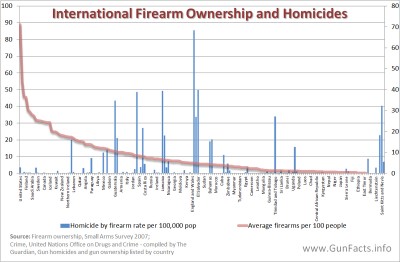
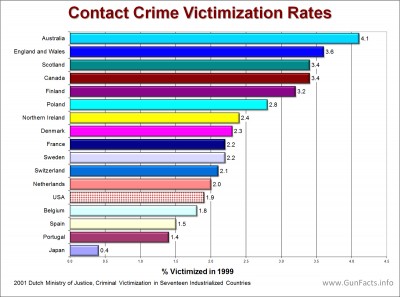
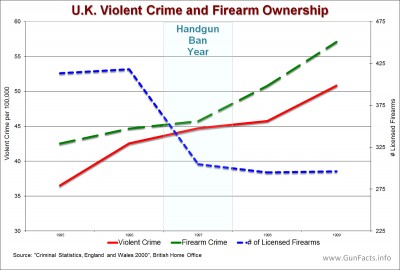
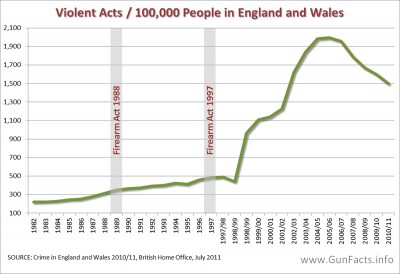
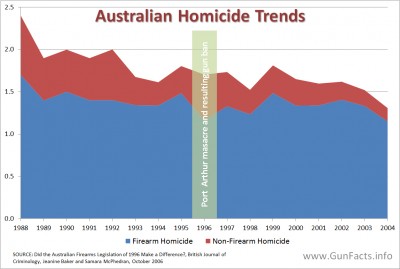
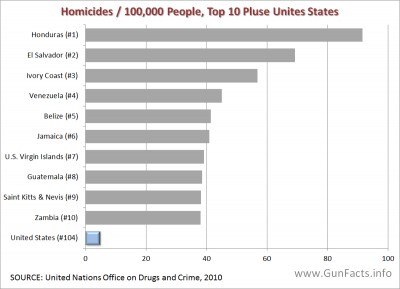
No comments:
Post a Comment
Thanks for commenting. Your comments are needed for helping to improve the discussion.